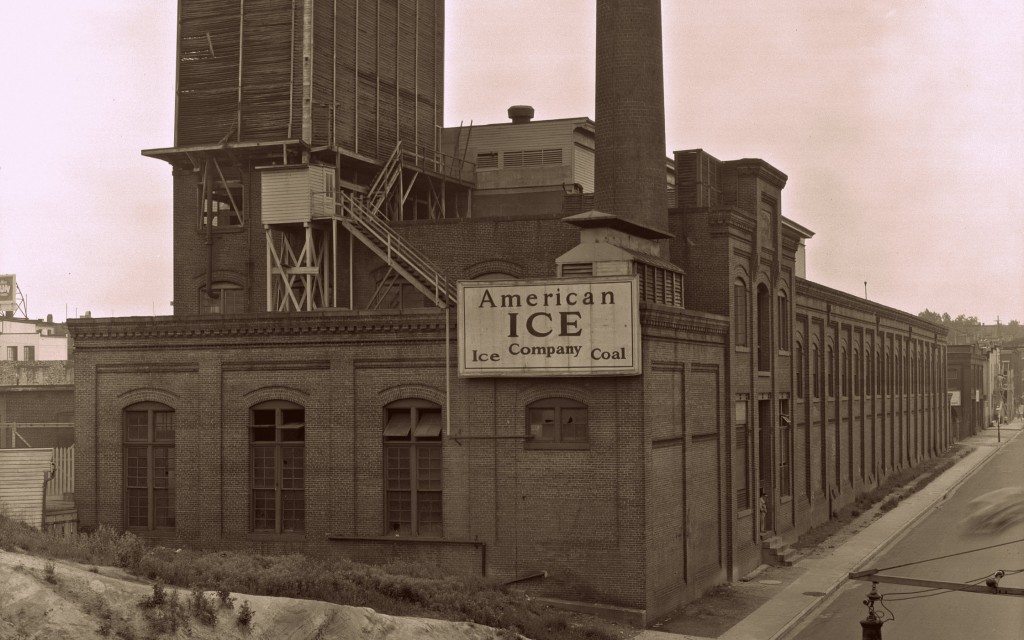Explore stories of a 100-year-old ice factory, the Sisters of Bon Secours, the Movement Against Destruction, and more just blocks from the West Baltimore MARC Station.
 When the Baltimore & Potomac Railroad laid train tracks across Edmondson Avenue in the 1860s, country mansions dotted the hills and small farms still grew produce for the city. Over the past 150 years, builders and entrepreneurs replaced mansions and farms with rowhouses, factories, churches, and schools. These buildings—modest and grand—are landmarks for the communities around the West Baltimore MARC Station.
When the Baltimore & Potomac Railroad laid train tracks across Edmondson Avenue in the 1860s, country mansions dotted the hills and small farms still grew produce for the city. Over the past 150 years, builders and entrepreneurs replaced mansions and farms with rowhouses, factories, churches, and schools. These buildings—modest and grand—are landmarks for the communities around the West Baltimore MARC Station.
Baltimore & Potomac Railroad and the West Baltimore MARC Station
The origins of the West Baltimore MARC Station began in 1858, when Charles County planters pushed for the Baltimore & Potomac Railroad to connect their farms to Baltimore. Progress remained slow until 1867, when the Pennsylvania Railroad Company bought the business. In July 1872, the completion of the Baltimore and Potomac Tunnel (below Winchester and Wilson Streets) enabled the B&P Railroad to start its route to DC. In 1983, the MARC train joined the list of commuter trains that have used those same tracks, ensuring the continued popularity of the station for travelers today.
American Ice Company
With a striking brick facade on Franklin Street and a powerhouse built next to the train tracks, the 1911 American Ice Company is one of many factories that employed thousands in West Baltimore. In the early 1900s, factories producing “manufactured ice” challenged companies that harvested natural ice from frozen rivers and lakes in the northeast. The American Ice Company survived this changing industry and grew, using horses and later trucks to deliver ice door-to-door for decades. A 2004 fire left the factory damaged but still standing proud and waiting for rehabilitation.
The East-West Expressway and the Movement Against Destruction
Fast growing suburbs and an increasing number of drivers in Baltimore inspired the city’s earliest plan for an “East-West Expressway” in the mid-1940s. By the late 1950s, the latest plan called for the demolition of a wide swath of West Baltimore. Black residents responded by organizing the Relocation Action Movement, joining with East Baltimore’s anti-highway activists to form the Movement Against Destruction. Despite this organized opposition, in the late 1960s the city demolished the blocks between the West Baltimore MARC Station and downtown. Just a few years later, MAD finally succeeded in its effort and the city abandoned the highway plan permanently.
Ward Baking Company Building
Built in 1925 over the loud protests of local residents who opposed a new factory in their residential neighborhood, the Ward Baking Company is a handsome brick box, designed by C.B. Comstock, a New York-based refrigeration architect and engineer. Based in Pittsburgh, the Ward Baking Company, then known as the Ward Bread Company, also had factories in the Bronx, Buffalo, and East Orange, New Jersey. Long retired as a factory, the building has more recently been used as a church.
Lockerman-Bundy Elementary School
“This is without doubt one of the finest school buildings in the city, containing as it does every convenience for the carrying on of the work of training the young mind in the way it should go.” The Afro-American Ledger, June 24, 1905
Despite its modern building, the history of Lockerman-Bundy Elementary School dates back to the 1890s. It is named after Joseph Harrison Lockerman (1864-1923), a graduate of the Centenary Biblical Institute (now Morgan State University) who in 1911 became Vice Principal of the new Colored High and Training School for African American teachers (now Coppin State University). Two years later, the training school moved into the upper floors of the new Public School 100 located at 229 North Mount Street. When the school relocated to Pulaski Street in 1976, the name expanded to honor Mrs. Walter A. Bundy (1904-1965). A graduate of Coppin State in 1918, Mrs. Bundy’s teaching career in Baltimore’s black schools spanned over four decades.
The Bridge Theater
One of the area’s earliest movie theaters, “The Bridge” opened in May 1915, seating 700 and featuring Paramount Pictures films. Under the management of Edmondson Amusement Company president Louis Schilchter, the Bridge Theater offered more than just movies. Schilchter hosted everything from song and dance shows to a community gathering to honor soldiers returning from WWI. After an explosion in 1930 damaged the side of the building, the theater rebuilt and continued to operate until 1968. Since 1970, the building has been used as a church and is presently home to the Life Celebration Center.
Bon Secours Hospital
The Sisters of Bon Secours, a French religious order, came to Baltimore in 1881. After establishing a convent at the western end of Baltimore Street, the sisters began administering home health care around the city. In 1919, they opened a hospital and, in 1921, started training nurses. Nearby Franklin Square Hospital left the neighborhood for the suburbs in 1969, but Bon Secours, then led by Sister Theophane Klingelhofer, made a commitment to stay. The hospital continues their leadership in West Baltimore today by making investments in health, housing and community greening.

